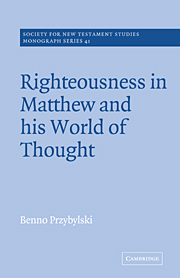Book contents
- Frontmatter
- Contents
- Preface
- Abbreviations
- 1 The problem of the meaning and significance of the Matthaean concept of righteousness
- 2 Tsedeq, tsedaqah and tsaddiq in the Dead Sea Scrolls
- 3 Tsedeq, tsedaqah and tsaddiq in the Tannaitic literature
- 4 The meaning of dikaiosynē, eleēmosynē and dikaios in the Gospel of Matthew
- 5 The relative significance of the concept of righteousness in the Gospel of Matthew
- 6 The provisional function of the Matthaean concept of righteousness
- Notes
- Bibliography and system of references
- Index of passages cited
- General index
4 - The meaning of dikaiosynē, eleēmosynē and dikaios in the Gospel of Matthew
Published online by Cambridge University Press: 18 December 2009
- Frontmatter
- Contents
- Preface
- Abbreviations
- 1 The problem of the meaning and significance of the Matthaean concept of righteousness
- 2 Tsedeq, tsedaqah and tsaddiq in the Dead Sea Scrolls
- 3 Tsedeq, tsedaqah and tsaddiq in the Tannaitic literature
- 4 The meaning of dikaiosynē, eleēmosynē and dikaios in the Gospel of Matthew
- 5 The relative significance of the concept of righteousness in the Gospel of Matthew
- 6 The provisional function of the Matthaean concept of righteousness
- Notes
- Bibliography and system of references
- Index of passages cited
- General index
Summary
Introduction
It has been demonstrated that in the Dead Sea Scrolls and the Tannaitic literature the terms tsedeq, tsedaqah and tsaddiq represent the righteousness terminology. In turning to the Gospel of Matthew the question thus emerges: are these Hebrew terms related to the Matthaean righteousness terminology?
As will become evident as this study progresses, tsedeq is in fact equivalent to dikaiosynē, tsedaqah in its meaning of alms to eleēemosynē and tsaddiq to dikaios. While in the final analysis only the foregoing conclusion based on the Gospel of Matthew itself provides a definitive answer to the question posed above, a look at the Greek translation equivalents employed in the LXX for the Hebrew terms under discussion is also illuminating inas-much as the Septuagintal usage points to trends reflected in the Gospel of Matthew.
It should not be surprising that Matthaean usage corresponds to Septuagintal usage in this case. Not only has the general conclusion been drawn that the ‘LXX constitutes the bridge between the OT and the NT’ and that it provides the ‘vocabulary for the NT writers’ but it has also been specifically demonstrated that Matthew made use of the LXX in the writing of his gospel.
In the Hebrew OT there are 115 occurrences of the noun tsedeq, 158 of the noun tsedaqah and 208 of the adjective tsaddiq. Ziesler has noted that out of the total number of occurrences of these three terms ‘only about 32 are not represented in LXX by some form of ικαι-’.
- Type
- Chapter
- Information
- Righteousness in Matthew and his World of Thought , pp. 77 - 104Publisher: Cambridge University PressPrint publication year: 1981



